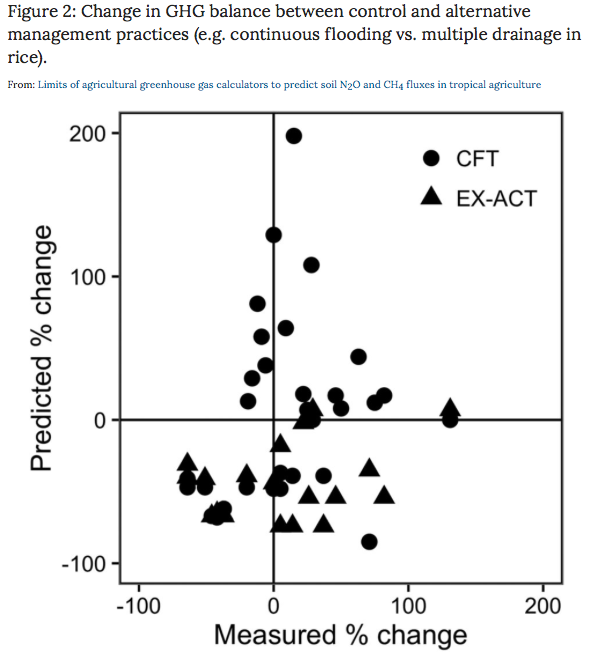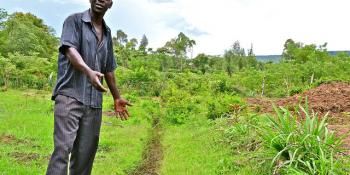World’s most popular greenhouse gas calculators for agriculture are not accurate in tropical developing countries

Over half of developing countries intend to decrease greenhouse gas emissions from agriculture, but commonly used methods to estimate agricultural emissions are not always accurate.
Download the article: Limits of agricultural greenhouse gas calculators to predict soil N2O and CH4 fluxes in tropical agriculture
Greenhouse gas calculators based on the simplest level of Intergovernmental Panel on Climate Change (IPCC) methods and data - called "Tier 1" - were sometimes unable to accurately predict changes in emissions due to changes in agricultural practices on typical farms in developing countries, according to a journal article published May 20 in Scientific Reports. In the article 'Limits of agricultural greenhouse gas calculators to predict soil N2O and CH4 fluxes in tropical agriculture,' the authors suggest data used to calculate emission factors and populate models largely come from research in temperate, developed countries and do not accurately represent conditions on small farms in tropical developing countries.
Need for better emissions estimates for tropical, smallholder agriculture
Developing countries constitute 70% of the potential for land-based mitigation from agriculture. Recognizing their potential, 52% of developing countries included decreasing greenhouse gas emissions from the agriculture sector in their plans to limit global warming prepared for the 2015 Paris climate change conference (COP21) and the Paris Agreement. But this research finds that the available methods to calculate emissions from agriculture can produce spurious estimates, a serious barrier to predict or monitor future emissions reductions.
Agriculture and climate scientists and climate policy leaders need tools to rapidly estimate emissions from agriculture and assess the potential impacts of policy and agricultural practice changes on emissions. This has catalyzed the development of “greenhouse gas calculators,” simple accounting tools that use a mix of emission factors and empirical models to calculate emissions with minimal input data. The calculators use methods and data from IPCC guidelines - the same methods used by national governments to report their greenhouse gas emissions. Governments are not the only stakeholders that have adopted greenhouse gas calculators. Companies, project managers, and farmers also use greenhouse gas calculators to anticipate or monitor the effects of agricultural practices.
Meryl Richards, lead author of the study and scientist for the CGIAR Research Program on Climate Change, Agriculture and Food Security (CCAFS) based at the Gund Institute for Ecological Economics at the University of Vermont, explained:
Calculators are useful for getting a general sense of the relative contribution of different activities to greenhouse gas emissions. However, even the best available calculators will not be able to provide precise estimates for developing countries if the calculators are based on data sets from countries with very different agricultural systems.
Current tools have mixed results
The study compared field measurements of soil emissions from smallholder farmers’ fields in Africa, Asia, and Latin America, with estimates produced by two of the most commonly used greenhouse gas calculators: the Cool Farm Tool, developed by the University of Aberdeen and the Sustainable Food Lab, and the Ex-ante Carbon Balance Tool (EX-ACT), developed and used by the Food and Agriculture Organization of the United Nations (FAO).
The calculators overestimated net GHG emissions 70% of the time, and 41% of the time the tool-predicted emissions were more than twice those obtained through field measurements. The tools were most likely to overestimate nitrous oxide emissions, which are generated primarily from fertilizer application.
The researchers also examined whether the calculators could predict the relative change in greenhouse emissions associated with a change in management. In other words, if a rice farmer switched from continuously flooding her fields to using alternate wetting and drying, would the calculators correctly predict whether emissions would increase or decrease?

Points in the upper right and lower left quadrants represent cases where the calculator predicted the same direction of change as observed in the field study. Points in the lower right and upper left quadrants represent cases where the calculator predicted the opposite direction of change as observed in the field study.
While the calculators are different, both calculators’ estimates were only able to predict how emissions would change in response to a change in agricultural management in about 60% of cases. Translation: we can only be confident of the results about two-thirds of the time.
The authors emphasize that their results reflect the limits of using IPCC Tier 1 data to estimate complex processes on individual farms, rather than a flaw in how greenhouse gas calculators are constructed.
Todd Rosenstock, a co-author and scientist at the World Agroforestry Centre (ICRAF) said:
These results raise concerns about using Tier 1 methods to estimate emissions from tropical farming systems. We need to broaden the scope of the data underlying these factors and equations to include quantitative data from tropical climates, including different soil types and agricultural management practices, such as fertilizer use.
Recommendations
The authors acknowledge that it will take time for agricultural and climate scientists to collect this vital data. In the meantime, the authors suggest alternative methods to improve GHG calculators’ accuracy. For example, calculators, and calculator users, should use published Tier 2 emission factors when available because they are generally specific to a country or region, and may be more accurate.
And data collection efforts are underway. CCAFS, which sponsored this study, is working with partners to provide emission factors using improved data from small farms in the developing world. Metadata for emissions measurements are available on the SAMPLES website. In partnership with the International Maize and Wheat Improvement Center (CIMMYT) and the University of Aberdeen, CCAFS is developing a new model for soil emissions resulting from nitrogen fertilizer application, which will be incorporated into greenhouse gas calculators.
These efforts will help countries around the world more accurately estimate and track their emissions from agriculture, and progress toward emissions reductions set out in their plans. Richards said:
Our focus is to improve data so that countries can accurately monitor emissions reductions in the context of national goals and our global efforts to limit climate change.
Read more about greenhouse gas emissions and estimation:
- Kimaro AA, Mpanda M, Rioux J, Aynekulu E, Shaba S, Thiong'o M, Mutuo P, Abwanda S, Shepherd K, Neufeldt H, Rosenstock TS. 2015. Is conservation agriculture 'climate-smart' for maize farmers in the highlands of Tanzania? Nutrient Cycling in Agroecosystems.
- Pelster DE, Gisore B, Goopy J, Korira D, Koske JK, Rufino MC, Butterbach-Bahl K. 2016. Methane and Nitrous Oxide Emissions from Cattle Excreta on an East African Grassland. Journal of Environmental Quality.
- Wollenberg E, w al. 2016. Reducing emissions from agriculture to meet the 2°C target. Global Change Biology.
- SAMPLES website. The Standard Assessment of Agricultural Mitigation Potentials and Livelihoods project aims to improve data on agricultural greenhouse gas emissions and mitigation potentials through data collection, developing low-cost measurement methods, and sharing research.
- CCAFS Low Emissions Agriculture website
- The Climate Food and Farming (CLIFF) Network is an international research network that helps to build the capacity of young researchers working on climate change mitigation in smallholder farming. Co-author George Nyamadzawo is a CLIFF Network member.
- Towards sustainable greenhouse gas inventories for Kenya and Uganda. Blog regarding recent visit to the Mazingira Laboratory in Kenya
- Experts call for local greenhouse gas emissions data. SciDev news article
Julianna White is Program Manager and Communications Specialist for the Low Emissions Agriculture Flagship.
Citation for journal article:
Richards MB, Metzel R, Chirinda N, Ly P, Nyamadzawo G, Vu QD, de Neergaard A, Oelofse M, Wollenberg E, Keller E, Malin D, Olesen JE, Hillier J, Rosenstock TS. 2016. Limits of agricultural greenhouse gas calculators to predict soil N20 and CH4 fluxes in tropical agriculture. Scientific Reports 6.



